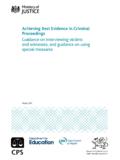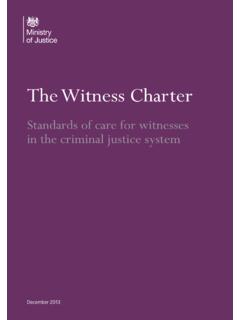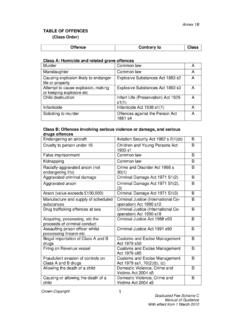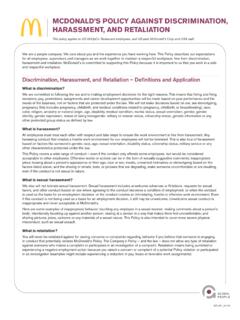Transcription of Dignity at Work – v2 - Crown Prosecution Service
1 Dignity at WorkStandards of behaviour in the Crown Prosecution Service Contents Foreword 2 Introduction Policy Statement 3 Dignity at work Framework 6 Examples of Unacceptable Behaviour 10 Annex 1 Examples of Discriminatory Behaviour 16 Annex 2 Glossary 18 Annex 3 Contacts 20 Annex 4 HR Policy Links 21 1 Foreword Introduction by the Director of Public Prosecutions and Chief Executive Our vision for the CPS is to be a high-performing, streamlined, Prosecution Service relentlessly focused on quality and respected for its professionalism. In order to deliver this vision, we must ensure that our staff are treated fairly and with respect and Dignity throughout the organisation.
2 In embedding a One CPS philosophy throughout the organisation, we are committed to developing our organisational culture to ensure that diversity and difference are actively celebrated and our workforce is reflective of the communities that we serve. Fairness and inclusion are fundamental principles for the CPS and we value the diversity of our staff and respect individual differences within an inclusive working environment. We want to continue to attract and retain a workforce that reflects diverse communities and we are committed to eliminating discrimination and complying with our equality statutory duties. We recognise the clear link between fairness and equality in our employment practices and our role as an open, transparent Prosecution Service .
3 We need to continue to develop our employment practices in order to build community confidence in the integrity of our decision making. Unacceptable behaviour has no place in our Service and will not be tolerated. The senior management team are the champions of the framework and will demonstrate clear leadership to ensure effective implementation. We expect managers and staff at all levels to uphold the principles of Dignity at work and the standards of behaviour outlined in this booklet to ensure a better working environment for all. Keir Starmer QC Peter Lewis Director of Public Prosecutions Chief Executive March 2012 2 Introduction 1.
4 Policy Statement The Crown Prosecution Service (CPS) is committed to respecting individual differences whilst pursuing a common purpose. We are committed to having a workforce that is treated fairly, with respect and feels valued for the contribution every member of staff makes. All staff are entitled to Dignity , respect and courtesy within the workplace and to not experience any form of discrimination. Discrimination of any form will not be tolerated within the Service . The CPS Equality and Diversity Statement outlines our commitment to developing a better working environment and a respectful and inclusive culture in which diverse contributions can flourish. These commitments are reinforced through the CPS People Strategy which outlines how staff should work together in a fair and inclusive manner in order to build a better Service .
5 Within the CPS, all staff are expected to treat each other with respect whatever their differences, grade level, job role or relationship manager and employee. As an employee working for the Department your responsibilities are: To ensure that the rights of others are respected and upheld; To be polite and take a positive, responsive and considerate approach when dealing with the public, colleagues and other agencies; To support and encourage an environment which values all people and not to cause embarrassment, conflict of interest, harassment , alarm or distress to another employee nor discriminate unfairly or unlawfully on any grounds; To avoid actions which may adversely affect the reputation of the Department; To maintain a professional approach to your work and colleagues.
6 To conduct yourself in accordance with the procedures and guidance set out in CPS Code of Conduct. 2. Equality Act 2010 The Equality Act 2010 outlines the provisions for employers in relation to making the workplace a fair environment and to comply with the law. It also sets out the different ways in which it is unlawful to treat someone, such as, direct and indirect discrimination, harassment , victimisation and failing to make reasonable adjustments for a disabled person. As an employer, the CPS is responsible for the prevention of bullying, harassment , discrimination and victimisation and other unacceptable behaviour within the workplace. 3 The Act extends protection to employees in protected characteristic groups.
7 These include: Age; Disab ility; Gender Reassignment; Marriage and Civil Partnership; Pregnancy and Maternity; Race (including ethnic origin, nationality and colour); Religion or Belief; Sex; and Sexual Orientation. harassment harassment and bullying on the basis of protected characteristics is discriminatory and unlawful. The Act defines harassment as: unwanted conduct related to a relevant protected characteristic that has the purpose or effect of creating an intimidating, hostile, degrading, humiliating or offensive environment for the complainant or violating the complainant s Dignity . The Act uses a single definition of harassment to cover protected characteristics and enables employees to complain about specific behaviour that they find offensive even if the behaviour is not directed at them.
8 Protection is also extended to harassment because of perception and association. harassment may be a persistent or an isolated incident and can be based on protected characteristics. The legislation offers protection to employees in relation to: Direct Discrimination can occur when a rule or policy disadvantages someone because of their particular characteristic. Indirect Discrimination can occur where a rule or policy that applies to everyone but disadvantages someone with a particular protected characteristic . However, it may not be discrimination if it can be shown to be a proportionate means of achieving a legitimate aim. Discrimination by association is direct discrimination against someone because they associate with another person who possesses a protected characteristic.
9 Discrimination by perception is direct discrimination against someone because they think they possess a particular protected characteristic. harassment by a third party employees are potentially liable for harassment of their staff by people they don t employ. 4 Discriminatory behaviour (including bullying and harassment ) can occur on the basis of actual or perceived group membership or affiliation. Victimisation occurs when an employee is treated badly because they have made or supported a complaint or raised a grievance under the Equality Act 2010; or because they are suspected of doing so. An employee is not protected from victimisation if they have maliciously made or supported an untrue complaint.
10 Bullying Bullying is considered as: Intimidation on a regular and persistent basis or as a one off, which serves to undermine the competence, effectiveness, confidence and integrity of the person on the receiving end. Bullying and harassment may be by an individual against an individual or involve groups of people. It is destructive rather than constructive and can publically humiliate and result in individuals feeling threatened or compromised. Bullying also often results from a misuse of management power, but is also the misuse of any form of individual power, such as physical strength, personality or age, or collective power through strength of numbers. Bullying can also be carried out by staff at all levels, including peers.

















